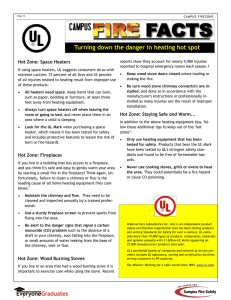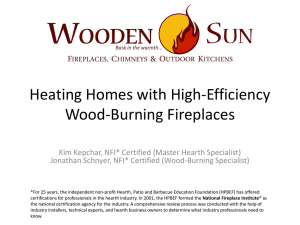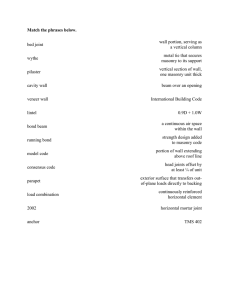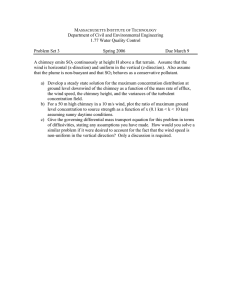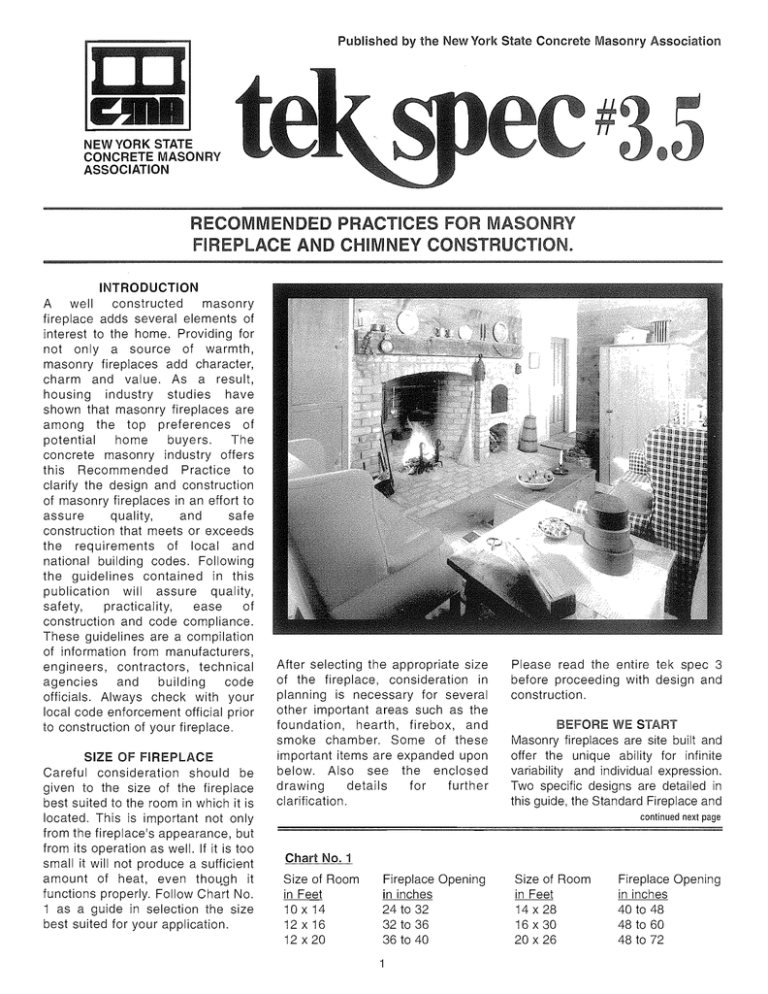
Published by the New York State Concrete Masonry Association
#
NEW YORK STATE
CONCRETE MASONRY
ASSOCIATION
RECOMMENDED PRACTICES FOR MASONRY FIREPLACE AND CHIMNEY CONSTRUCTION. INTRODUCTION
A
well
constructed
masonry
fireplace adds several elements of
interest to the home. Providing for
not only a source of warmth,
masonry fireplaces add character,
charm and value. As a result,
housing industry studies have
shown that masonry fireplaces are
among the top preferences of
potential
home
buyers.
The
concrete masonry industry offers
this Recommended Practice to
clarify the design and construction
of masonry fireplaces in an effort to
assure
quality,
and
safe
construction that meets or exceeds
the requirements of local and
national building codes. Following
the guidelines contained in this
publication will assure quality,
safety,
practicality,
ease
of
construction and code compliance.
These guidelines are a compilation
of information from manufacturers,
engineers, contractors, technical
agencies
and
building
code
officials. Always check with your
local code enforcement official prior
to construction of your fireplace.
SIZE OF FIREPLACE
Careful consideration should be
given to the size of the fireplace
best suited to the room in which it is
located. This is important not only
from the fireplace's appearance, but
from its operation as well. If it is too
small it will not produce a sufficient
amount of heat, even thou.gh it
functions properly. Follow Chart No.
1 as a guide in selection the size
best suited for your application.
After selecting the appropriate size
of the fireplace, consideration in
planning is necessary for several
other important areas such as the
foundation, hearth, firebox, and
smoke chamber. Some of these
important items are expanded upon
below. Also see the enclosed
drawing
details
for
further
clarification.
Please read the entire tek spec 3
before proceeding with design and
construction.
BEFORE WE START
Masonry fireplaces are site built and
offer the unique ability for infinite
variability and individual expression.
Two specific designs are detailed in
this guide, the Standard Fireplace and
continued next page
Chart No.1
Size of Room
in Feet
10 x 14
12 x 16
12 x 20
Fireplace Opening
in inches
24 to 32
32 to 36
36 to 40
Size of Room
in Feet
14 x 28
16 x 30
20 x 26
Fireplace Opening
in inches
40 to 48
48 to 60
48 to 72
the Rumford Fireplace. The Standard
Fireplace (see p.4-5) has a short
firebox with the back wall leaning
forward. The Rumford Fireplace(see
p.6-7)is tall with widely splayed
sidewalls and an aerodynamic curved
throat that improves draft and reduces
emissions. The heating ability of the
Rumford is legendary. The ease of
construction, and the visual appeal of
the tall opening makes the Rumford a
very popular feature with architects
and home builders.
Although there are many design
variations that are quite acceptable for
masonry fireplaces,
the same
principles of construction apply for all
designs
as
outlined
in
this
specification. Of particular importance
are
minimum
clearance
to
combustibles, building codes, and
specifications of materials.
Again please read this entire
speCification for help to assure a
quality firesafe installation.
FOUNDATION
The foundation consists of concrete
footings and masonry walls. Minimum
code requirements must be met with
respect to foundation and wall design.
Unless specifically designed for
additional loads, no other part of the
structure or adjoining structure should
be supported by the chimney.
Immediately above the foundation
walls, support for the combustion
chamber and the extended hearth is
provided by a cast in place or precast
concrete slab. The forming of the
concrete slab requires chases be cast
for outside combustion air vents and
ash dumps. If a permanent form is
used it must be non-combustible, (Le ..
steel, slate, or corrugated metal). The
concrete slab must not support the
floor system.
FIREBOX AND HEARTH
All materials used to construct the
firebox, hearth, and hearth extension
must be completely non-combustible
masonry materials. Brick or stone are
most popular. In no instance may
combustible elements offer support to
the hearth or fireplace
_
For fireplaces up to 6 sq. ft. (or an
opening of approximately 3' x 2') the
hearth extension must project 16
inches in front of the fireplace and 8
inches beyond each side of the
fireplace opening. For larger sized
openings these dimensions increase
to 20 inches in front and 12 inches on
the sides. The fireplace hearth and
sidewalls are constructed of a
minimum of 2 inches or firebrick laid in
refractory mortar. Note the firebox is
surrounded by 4 inch solid block for
structural stability and thermal heat
storage (refer to drawings for
minimum total wall thickness).
Firebrick made to the specifications
listed will provide minimal expansion
and contraction throughout the
operating temperature of residential
fireplaces and chimneys. Therefore,
no allowance to accommodate
movement of firebrick is included.
All firebrick must be installed in
refractory mortar. The back side of the
firebox shall be parged with mortar
adding to its strength. Regular
masonry mortar may be used here.
The fill behind the firebox shall be
non-combustible rubble or solid
masonry.
PLACEMENT OF THE DAMPER
AND LINTELS
Metal parts have a greater coefficient
of expansion than masonry units.
Room for expansion or movement
must therefore be provided. The
damper should be laid on the top of
the firebrick box in a bed of refractory
mortar only thick enough to assure a
level damper installation. A 1/8" to 114"
space should be left at the ends of the
damper flanges. The damper shall not
support any masonry. Any fireplace
lintel shall be installed in a similar
manner on a bed of mortar (for
leveling purposes) with a 1/8" to 114"
space on sides and ends. This space
may be filled with non-combustible
soft material such as fiberglass
insulation or refractory blanket. Any
masonry corbeled from the firebox
shall not bear on the damper
assembly. To prevent this, a second
lintel may be installed with the same
provisions for thermal expansion and
the lintel installed above the fireplace
opening.
SMOKE CHAMBER
The smoke chamber located directly
above the firebox shall be constructed
of 2" thick firebrick, a manufactured
2
vitrified clay smoke chamber or a 4"
solid masonry. A 1/2" to 3/4" thick
parged refractory may be required
over corbeled firebrick to form a
smooth surface to easily transition
smoke and gases up through the
smoke chamber. (Refer to drawings
for minimum total wall thickness).
The smoke chamber, for Standard
Fireplace DeSign, shall be constructed
so the sidewalls and front wall taper
inward to form the support of the
fireplace chimney. The chimney shall
be positioned so that it is centered on
the width of the fireplace and the back
of the flue liner is aligned flush with
the vertical rear surface of the smoke
chamber. This configuration provides
for smooth uninterrupted exiting of
smoke and gases from the fireplace
into the chimney. NOTE: The Rumford
Throat and Smoke Chamber are
usually made of preformed parts.
(See
p.
6-7).
Follow
the
manufacturers instructions.
CHIMNEY
The chimney is constructed directly on
the smoke chamber. The chimney
consists of a flue liner and chimney
wall. The chimney wall shall be
constructed so there is at least a 4
inch nominal thickness of solid
masonry between the flue liner and
any exterior surface. Solid masonry
products for the chimney wall
construction are those (brick, block, or
stone) which are either 100% solid or
those which have cores or holes of
any configuration which do not exceed
25% of the gross cross sectional area
of any load bearing surface. The
Chimney shall be separated from the
flue liners by an air space not greater
than the thickness of the clay flue
liner. This will assist the clay flue to
stay in alignment as well as permit the
clay flue to expand or contract freely.
All spaces between chimneys and
floors and ceilings through which the
chimneys pass shall be firestopped
with non-combustible material. The
firestopping of spaces between
chimneys and wood joists, beams, or
header shall be galvanized steel not
less than 26 gauge or non­
combustible material not thinner than
1/2 inch. Clay flue liners shall be
installed bedding one on the other in
refractory mortar with close-fitting
joints left smooth on the inside and
outside face of the flue liner.
Depending on the size and design of
the chimney the mason may choose
to install an additional wythe or by
other accepted methods (i.e. corbel
headerconstruction, etc.) to insure the
structural integrity of the clay flue
lining. The flue lining and surrounding
masonry shall touch only in spot
locations (not to exceed two inches
square each) to assure proper
alignment and support. In no case will
the clay flue liner be encased
completely around its circumference
at one location. Clay flue liners made
to the listed specifications may
expand or contract during the
operating temperatures of residential
fireplaces and chimneys. This
publication allows for such movement.
When more than one flue is
contained in a chimney, a separation
shall be provided between adjacent
flues. The separation shall be
constructed of solid masonry wythes
(walls) not less than 4 inches,
nominal, in thickness and the wythes
shall be bonded to the chimney walls
with either ties or masonry mortar.
The chimney must extend at least
2 feet above the highest point where it
passes through the roof. In addition
the top of the chimney should be at
least 2 feet above any portion of the
building that is within 10 feet of the
chimney. Good draft is normally
achieved if the chimney height is such
that the vertical distance from the top
of the fireplace opening to the top of
the chimney is at least 15 feet. If the
chimney is less than 15 feet a larger
clay flue size should be considered
than what is required for a chimney of
15 feet or more.
CHIMNEY CAP
Every masonry chimney should have
a chimney cap to terminate the
masonry and protect the chimney.
This cap can be precast concrete or
cast in place concrete.
The chimney cap shall extend
beyond the exterior face of the
masonry and incorporate a drip slot or
other characteristic, to prevent
moisture penetration from the fop of
the masonry wall to the chimney.
The cap shall never be cast tightly
against the flue Liner. A gap should be
left to accommodate expansion and
contraction of the flue lining. The gap
at the top between the cap and flue
liner should be sealed with caulk to
prevent entrance of water into the
chimney. This is a maintenance joint
that should be c~ecked on a regular
basis to insure water tightness and
replaced when necessary.
The use of quality polysulfide,
butyle, or silicone rubber caulking
compound is recommended. Oil
based sealants do not perform well
here. Backer rod also is suggested to
support caulk around flue.
FLASHING
Base flashing and counter flashing are
installed at the chimney/roof interface.
The base flashing is installed first on
the
faces
of
the
chimney
perpendicular to the ridge line with
tabs at each corner. The flashing shall
extend a minimum of 4 inches up the
face of the chimney and along the
roof. Counter flashing is then installed
over the base flashing. It is inserted
into the mortar jOint for 3/4 to 1 inch
and mortared solidly into the jOint. The
counter flashing shall lap the base
flashing by at least 3 inches. If the
flashing is installed in sections the
flashing higher up the roof line shall
lap over the lower flashing a minimum
of 2 inches. All joints in the same base
flashing and counter flashing shall be
thoroughly sealed. The unexposed
side of any bends in the flashing shall
also be sealed.
MATERIAL SPECIFICATIONS
Use only those materials conforming
to the following specifications.
A. Concrete Block - conforming to
ASTM C-90 Grade N, ASTM C-129
B. Mortar Mix - ASTM C-270 Type N
C. Concrete Mix - for hearth slab and
chimney cap should conform to ASTM
C-39
D. Brick - ASTM C-55 (or 216 G rade­
SW)
E. Caulking - Polysulfide, Butyl or
Silicone Rubber
F. Flashing - Corrosion resistant
metal. No aluminum
3
G. Clay Flue Liners - Clay Flue Lining
Institute and ASTM C-315, C1283
H. Firebrick - ASTM C-27 or C-1261
low duty 2" thick minimum.
I. Refractory mortar - Non water
soluble refractory mortar is best for
installing both firebrick and clay flues.
Homemade mixes combining fireclay
and mortar simply do not meet the
code. Refractory parge for smoke
chamber must also be non-water
soluble.
See
manufacturers
instructions. All above must meet the
high temperature requirements of
ASTM C-199.
J. Dampers - should be certified to
have air infiltration losses not to
exceed 20 cubic feet per minute when
in the closed position.
K. Steel Angle - meeting ASTM A-36
with
minimum
dimensions
as
specified in Chart 11.
CLEARANCE TO COMBUSTIBLES
One of the most important fire safety
requirements is the air space that
separates
the
chimney
from
combustible materials such as
framing. For interior chimneys this
space must be 2 inches minimum. For
an exterior chimney this space must
be 1 inch minimum. This space
insulates chimney from transferring
heat to the combustible materials and
must not be filled except for required
firestopping.
When
masonry
fireplaces and chimneys are part of a
masonry wall combustible materials
shall not be in contact with the
masonry less than 12 inches from the
inside surface of the flue lining or
firebox.
Exposed combustible trim and the
edges of sheathing materials such as
wood siding, flooring and drywall shall
be permitted to abut fireplace and
chimney walls provided they are at
least 12 inches from the inside
surface of the fireplace or flue lining.
Woodwork or other combustible
materials shall not be placed within 6
inches of the fireplace opening.
Combustible material within 12 inches
of the fireplace opening shall not
project more than 1/8 inch for each 1
inch distance from such opening.
MIN. 2'-0" ABOvt: THE HIGHEST
POINT WHERE THE CHIMNEY .&
ROOF INTERSECT. MIN. 2'-0"
ABOVE ANY PART OF THE ROOF WITHIN A HORIZONTAL DISTANCE
OF 10'-0"
B
ALL W1EATHER
ROD .& JOINT
CRETE CAP
4" SOLI
BLOCK,
CHIMNEY WALLS MUST BE
A MIN, OF 4" SOLID
MASONRY
METAL FLASHING
1l';'Z.-_ _
I""I!_~ 13"X13" CLAY FLUE LINER
INTERIOR FRAME WOOD WALL
2"X4" OR 2"X6" TYPICAL
MIN. I" AIR SPACE FROM COMBUSTIBLES TO 4"
SOLID MASONRY FOR CHIMNEYS ON EXTERIOR
WALLS MIN. 2" AIR SPACE FOR CHIMNEYS
PASSING THROUGH INTERIOR WALLS
8 1/2"X 8 1/2" CLAY FLUE
LINER FOR SECONDARY
HEAT SOURCE FROM - - - - - l.....fIf-­
BASEMENT.
8" THIMBLE FOR
SECONDARY HEAT SOURCE,
MUST BE 18" FROM
COMBUSTIBLES OR USE
APPROVED CLEARANCE
REDUCTION SYSTEM
MASONRY
SECTION D-D
DAMPER MUST BE CERTIfiED TO HAVE AIR
IN,ILTRAnON LOSSES IN CLOSED POSITION NOT
TO EXCEED 20 CUBIC FT. PER MINUTE. SMOKE CHAMBER WALL THICKNESS 6" MIN.
WHEN LINED WITH VITRIFIED CLAY OR
FIREBRICK. WITHOUT LINING 8" MIN. THK.
MAX. AIR SPACE NOT
GREATER THAN THE WALL
THICKNESS OF FLUE
4" SOLID OR 6" HOLLOW MASONRY UNITS.
w/ CELLS FULLY FILLED w/ MORTAR
MAX. AIR SPACE NOT GREATER THAN
THE WALL THICKNESS OF FLUE
13"X13" FLUE LINER MIN.
RUBBLE FILL OR SOLID MASONRY
BACKSIDE OF FIREBOX FIREBRICK
PARGED W/ MASONRY CEMENT MIX
TOTAL THICKNESS OF THE
FIREPLACE WALLS INCLUDING
FIREBRICK LINING MIN. 8"
FIRE STOP: SEE NOTE ABOVE
OUTSIDE
AIR INTAKE NOTE: MAINTAIN MIN. 2"
CLEARANCE FROM FIREPLACE
TO COMBUSTIBLE FRAMING
MEMBERS
PARGE SMOOTH WITH REFACTORY
MOTAR. FOLLOW MANUFACTURES
INSTRUCTIONS
ANGLES .& DAMPER TO
BE INSTALLED WITH 1/4"
CLEARANCE ON EA. END
FOR POSSIBLE EXPANSION
TOTAL THICKNESS OF BACK
WALL AND SIDES OF
FIREBOX IS 8"
MAX. AIR SPACE NOT
GREATER THAN THE WALL
THICKNESS OF FLUE
STAGGER FLUE JOINTS. NOT TO COINCIDE WITH OTHER MASONRY JOINTS.
MAX. AIR SPACE NOT
GREA TER THAN THE WALL
THICKNESS OF FLUE
BASE OF FIRST FLUE MUST BE
CONTINUALLY SUPPORTED ON ALL
SIDES.
4" SOLID MASONRY WYTHE - - - - - -
ALL WEATHER CAULK - - - - _ - ' " l l
8-1/2"X 8-1/2" CLAY FLUE LINER
FOR SECONDARY HEAT SOURCE
REFRACTORY MORTAR 1/16" TO
l/S" JOINT THICKNESS MAX. USE NON-WATER SOLUBLE REFRACTORY MORTAR 13" X 13" CLAY FLUE LINER
FIRE STOP: 26 GA GALVANIZED STlEEL OR NON­
COMBUSTIBLE SHT. MTR'L 1/2" THICK MAX.
MAX. AIR SPACE NOT GREATER
THAN THE WALL THICKNESS OF FLUE
FIREBOX LINED WITH MIN. 2" THICK FIREBRICK
(HEARTH .& SIDE LAID IN REFRACOTRY MORTAR) SEE
SPEC INFORMATION FOR REFRACTORY MORTAR IN
TEXT. JOINT THICKNESS 1/16" TO 3/16" ACCEPTABLE.
FOLLOW MANUFACTURES INSTRUCTIONS.
d~L RW' ~Efol~~Uft~L~tCK
8 1/2" X 8 1/2" CLAY
FLUE LINER FOR
SECONDARY HEAT
SOURCE
ALL-
5/8" WALL THICKNESS
AS
THER CAULK
FIREBRICK LAID iN REFRACTORY
MORTAR
L_--"L-".,.,Jr-- OUTSIDE
AIR INTAKE ENTERS FIREBOX IN HEARTH OR LOWE:R
SIDE WALLS OF FIREBOX
4" SOLID POURED CONCRETE WITH
REMOVABLE FORM OR WITH
NON-COMBUSTIBLE FORM. 1/2" REBAR
PLACED 6" APART OR OTHER
NON-COMBUSTIBLE HEARTH EXTENSION
~NE ~F FINISHED
ASH DUMP MAY BE SEPERATE FROM AIR INTAKE
CHART II
RAD D VARIES
CONSTRucnON DIMENSIONS, INCHES (APPROX.)
PROPERLY DESIGNED _ _ _ _---!_
FOU NDA TI ON
;-"..,--'--.....,....--'.---1
FIREPLACE OPENING ASH PIT
A
MIN. 4" FLOOR SLAB
B
C
D
OF ASH PIT
o
A
26 i 36 26
• 42 32
48 32
54 36
60 38
.72 40
16 18
20 24
20 30
20
20
22
22
TG SIZE
STEEL ANGLE
E
o
INCHES
24 16 12 14
FILL W/CONCRETE MIX
TO BOTTOM OF CLEAN
OUT DOOR.
UNDISTURBED OR
COMPACTED SOIL
SIDING MAY EXTEND BEHIND MASONRY BUT MUST 8E HELD BACK A MIN. OF 1" FROM INSIDE FACE. • 8,5X13
8.5X13
13X13
13X13
16X16
16X20
16X20
20X20
14
14
14
14
P
44 72
44: 78
52 84
52 90
52 96
52102
52108
52120
UNDISTUR8E[)~R
COMPACTED :ElL
NOTES:
1. FOR PURPOSE OF ILLUSTRATION IN THIS SPECIFICATION WE HAVE CHOSEN A STANDARD 36" (DIM.A) FIREPLACE AND
CHIMNEY WITH A SECOND FLUE FROM THE BASEMENT ELEVATION FOR A SECONDARY HEAT SOURCE.
2. THE DRAWING HAS BEEN REDUCED FROM AN ORIGINAL. DO NOT SCALE OR PROPORTION DIMENSIONS FROM THIS
DRAWING.
3. BOTH THE INSIDE TEXT AND THE DRAWING DETAILS MUST BE REFERRED TO PRIOR TO CONSTRUCTIONS. READ ALL OF
TEK SPEC 3 BEFORE PROCEEDING.
SECTION A-A
4. FOR MATERIAL SPECIFICATIONS REFER TO PAGE 3 IN THE TEK SPECIFICATION.
5. INTERIOR MASONRY FIREPLACES 4" AIRSPACE FROM BACK FACE OF FIREPLACE TO
COMBUSTIBLE FRAMING MEMBERS.
6. FOR FIREPLACE OPENINGS OF 6 SQUARE FEET OR LARGER: A HEARTH ExTENSION OF 20' MINIMUM IS REQUIRED.
HEARTH EXTENSION MUST ALSO EXTEND AT LEAST 12" BEYOND EACH SIDE OF OPENING. FOR FIREPLACE OPENINGS
LESS THAN 6 SQUARE FEET: A HEARTH EXTENSION Of' 16" MINIMUM IS REOUIRED - HEARTH EXTENSION MUST ALSO
EXTEND AT LEAST 8" BEYOND EACH SIDE OF OPENING.
7. A SOLID MASONRY UNIT IS DEFINED AS A MASONRY UNIT WHOSE NET CROSS SECTIONAL AREA IN EVERY PLANE PARALLEL TO
THE BEARING SURF ACE IS 75% OR MORE OR n's GROSS CROSS- SECTIONAL AREA IN THE SAME PLANE.
4
5
ALL WEATHER CAULK
BACK-UP ROD & JOINT
FILLER
CONCRETE CAP
FIREBOX LINED WITH MIN. 2" THK. FIREBRICK (HEARTH
AND SIDE WALLS LAID IN REFRACTORY MORTAR) SEE
SPEC. INFO. FOR REF ACTORY MOTAR IN TEXT. JOINT
THICKNESS 1/16" TO 3/16" ACCEPTABLE, FOlLOW
MANUFACTURE'S INSTRUCTIONS.
MIM. 2'-0" ABOVE THE HIGHEST
POINT WHERE THE CHIMNEY & ROOF
INTERSECT. A MIN. 2'-0" ABOVE
ANY PART OF THE ROOF WITHIN A
HORIZONTAL DISTANCE OF 10'-0' ___
- CHIMt;jEY WALLS MUST BE A MINIMUM
OF 4 SOLID MASONRY
4" SOLID MASONRY
(BRICK B~OCK,
OR ST 6NE)
8 1/2 X 8 1/2 CLAY FLUE LINER FOR SECONDARY HEAT
SOURCE
MAX. AIR SPACE NOT
GREATER THAN THE WALL
THICKNESS OF FLUE
METAL FLASHING
ROOF LINE
~::: 13" X 13" CLAY FLUE LINER
MAX. AIR SPACE NOT GREATER THAN THE WALL THICKNESS OF FLUE 4" SOLID MASONRY WYTHE---
-
NON-COMBUSllBLE
FIRE BLOCKIN(';------iI
13"X13" CLAY FLUE LINER
q
MIN. r' AIR SPACE FROM
COMBUSTIBLES TO 4" MASONRY
FOR CHMNEYS ON EXTERIOR
WALLS. MIN. 2" AIR SPACE FOR
CHIMNEYS PASSING THROUGH
INTERIOR WALLS.
ALL WEATHER CAULK
STAGGER FLUE JOINTS NOT TO
COINCIDE WITH OTHER MASONRY
JOINTS
NON- COMBUSTIBLE\
DRYWALL
MAXIMUM AIR SPACE NOT GREATER
-THAN THE WALL THICKNESS OF FLUE
~R~Q~Al1~STON.t:R B10~K OR BRICK BAND IN
I'
r
NE~D~ y~
t WJt.'j~E~"T§HJ~~PAI~A~~ACE
OR CLEARA CE REQUIREMENTS
NOTE: MAINTAIN MIN. 2" CLEARANCE
FROM FIREPLACE TO COMBUSTIBLE
FRAMING MEMBERS
SECTION D-D
SMOKE CHAMBER WALL THICKNESS 6" MIM.
WHEN LINED WITH VlTRIFIED CLAY OR
FIREBRICK. WITHOUT LlNINC 8" MIN. THK.
- DAMPERS MUST BE CERTIFIED TO HAVE
AIR INFILTRATION LOSSES IN CLOSED
POSITION NOT TO EXCEED 20 CUBIC
FEET PER MINUTE
4" SOLID OR 6~ HOLLOW MASONRY UNITS.
W/ CELLS FULLY FILLED wi MORTAR
MAX. AIR SPACE EQUAL TO OR
LESS THEN THE WALL
THICKNESS OF FLUE
- BASE OF FIRST FLUE MUST BE
CONTINUALL Y SUPPORTED ON ALL
SIDES
8 1/2"x 8 1/2" CLAY FLUE
METAL FLASHING AS REQUIRED.
ALL­
FIRE STOP: SEE NOTE ABOVE
FIREBRICK LAID IN REFRACTORY
MORTAR
FRAMING MEMBER
OUTSIDE AIR INTAKE ENTERS
FIREBOX IN HEARTH OR LOWER
SIDE WALLS OF FIREBOX
4" SOLID POURED CONCRETE 'MTH
REMOVABLE FORM OR WITH
NON-CONBUSTIBLE FORM. 1/2"
REBAR PLACED 6" APART OR
OTHER NON-COMBUSllBLE HEARTH
EXTENSION.
LINE OF FINISHED
GRADED VARIES
PROPERLY
DE~GNED
CHART II
FOUNDA1l0N CONSTRUCTION DIMENSIONS. INCHES (APPROX.)
A
-BOTTOM OF ASH PIT
MIN. 4" FLOOR SLAB
G
24 24-28 12 113.5
3
3.5
30
36
48
60
72.
UN JNDISTURBED OR
CO:OMPACTED SOIL
SECTION
6
8-B 3
B
DEPTH
D
42
A-A
HROAT
FIREPLACE OPENING
ASH PIT
FILL WITH CONCRETE MIX
TO BOTTOM OF
CLEAN OUT DOOR
SIDING MA
MASONRY
BACK A MIN.
INSIDE FACE
LINE OF FINISHED
GRADED VARIES
FIREPLACE ASH DUMP
MAY BE SEPARATE
FROM AIR INTAKE.
SECTION
MAX. AIR SPACE NOT GREATER THAN
THE WALL THICKNESS OF FLUE
13"X13" FLUE LINER MIN.
5/8" WALL THICKNESS
8 1/2 X 8 1/2 CLAY FLUE
LINER FOR SECONDARY HEAT
SOURCE
THE TOTAL THICKNESS OF THE FIREPLACE
WALLS, INCLUDING THE F~EBRICK LINING
SHALL 8E MINIMUM OF 8
LINER FOR SECONDARY HEAT
SOURCE FROM BASEMENT.
8" THIMBLE FOR SECONDARY
HEAT SOURCE FROM BASEMENT
MUST BE 18" FROM
COMBUSTIBLES OR USE
APPROVED CLEARANCE
REDUCTION SYSTEM.
TOTAL THICKNESS OF
BACK WALL AND SIDES
OF FIREBOX IS 8" MIN.
OUTSIDE AIR
INTAKE
28-32
32-38
38-42
42 48
45-54
45 60
C
I
12 13.5
14 13.5
15 15
16 1B
20 22.5
24 27
OUNDATION HEARTH
SMOKE
EXTENSION
CHAMBER SIZE
M N
I
K
H
L
24 60
24 66
18 24, 72
18 124 78
1B 24 84
30 28 96
30 32 108
24
19
34
18
4
I 34
4.25 : 34
34
5.25
10
50
10
57
48
54
60
66
72
84
96
16
16
20
20
20
20
20
INCHES
FIREPLACE
FLUE SIZE
INCHES
36,,3,,3,,3/16
36x3,,3x3/16
42x3x3x3/16
48x3x3,,3/16
54x3x3x1/4
60x3,,3x1/4
66x3,,3,,1/4
8.5)(13
13X13
13X13
13X18
16X20
20X20
24X24
STEEL ANGLE
FTGSlZE
o •P
36 72
36 78
36184
36: 90
36196
4011 08
441120
NOTES:
1. FOR PURPOSE OF ILLUSTRATION IN THIS SPECIFICATION WE HAVE CHOSEN A STANDARD 36" RUMFORD (DIM. A) FIREPLACE AND
CHIMNEY WITH A SECOND FLUE FROM THE BASEMENT ELEVATION FOR A SECONDARY HEAT SOURCE.
2. THE DRAWING HAS BEEN REDUCED FROM AN ORIGINAL DO NOT SCALE OR PROPORTION DIMENSIONS FROM THIS
DRAWING.
3. 80TH THE INSIDE TEXT AND THE DRA'MNG DETAILS MUST BE REFERRED TO PRIOR TO CONSTRUCTIONS. READ ALL OF
TEK SPEC 3 BEFORE PROCEEDING.
4. FOR MATERIAL SPECIFICATIONS REFER TO PAGE 3 IN THE TEK SPECIFICATION.
5. INTERIOR MASONRY FIREPLACES REQUIRE 4" AIRSPACE FROM BACK FACE OF FIREPLACE TO
COMBUSTIBLE FRAMING MEMBERS.
6. FOR FIREPLACE OPENINGS OF 6 SQUARE FEET OR LAI:\GER: A HEARTH EXTENSION OF 20' MINIMUM IS REQUIRED.
HEARTH EXTENSIOt:l MUST ALSO EXTEND AT LEAST 12 BErOND EACH SIDE OF OPENING. FOR FIREPLACE OPENINGS
LESS THAN 6 SQUARE FEET: A HEARTH EXTENSION OF 16 MINIMUM IS REOUIRED - HEARTH EXTENSION MUST ALSO
EXTEND AT LEAST 8" BEYOND EACH SIDE OF OPENING.
7. A SOLID MASONRY UNIT IS DEFINED AS A MASONRY UNIT WHOSE NET CROSS SECTIONAL AREA IN EVERY PLANE PARALLEL TO
THE BEARING SURFACE IS 75% OR MORE OR IT'S GROSS CROSS-SECnONAL AREA IN THE SAME PLANE.
8. FOR SPECIFIC DIMENSIONS REGARDING RUMFORD DESIGN FOR OTHER THAN 36" RUMFORD ILLUSTRATED HERE REFER TO
MANUF ACTURERS ILLUSTRATIONS.
7
BALANCING THE VENTILATION
SYSTEM
In order for a fireplace, which utilizes
natural draft to function properly, a
supply of makeup air must be
available to replace the air exhausted
up the chimney. In older homes there
is often enough leakage around doors
and windows to provide this air. In
newer, tighter homes another source
of air may need to be provided. Before
lighting the fire, use incense or a
candle to determine if there is an
updraft or a down draft in the chimney.
If there is no updraft try cracking open
a window or door to provide a source
of air to the room. If any problem
persists you may need to locate other
sources of air entering or being
exhausted from the home. Exhaust
fans and opening the attic or upstairs
rooms may be sources of air flowing
out of the building. Warm air tends to
flow out from the upper floors and cold
air flows in down lower in the house. If
you determine that you need a
permanent source of makeup air,
contact a heating and ventilating
specialist and discuss the various
options. Fireplaces will exhaust
400cfm to 1000cfm depending on size
and intensity of the fire.
REDUCING CREOSOTE BUILDUP
One method for reducing creosote
buildup is to gradually stoke a medium
hot fire for 15 to 30 minutes at least
once a day, which tends to burn off the
creosote in small amounts. Seasoned
or dry wood will form less creosote
deposits than unseasoned or wet
wood. In mild weather, frequent slow
burning of the fireplace will severely
aggravate the creosote problem.
Frequent inspection of chimney
flues is important, especially during
the first season. Any problems that
may be occurring can be corrected
before they become hazards. Inspect
chimneys from the roof using a
flashlight, or use a mirror to look up
through the chimney flue. Any time an
inspection shows soot or creosote
buildup the chimney should be
cleaned.
CAUTION: The use of chemicals
which are supposed to clean the
chimney when they are placed on a
fire could produce heat intense
enough to cause damage to the
concrete masonry and clay flue liners
which could contribute to the
deterioration of those elements.
TIPS ON SAFE FIREPLACE
OPE8ATIONS
A fireplace fire, properly laid and fed,
is easy to tend and trouble free. Here
is a good method for building a fire.
* Be sure the damper is open before
lighting the fire!
* Use a small amount of paper and a
moderate number of kindling wood
pieces to lay down the bases. Place
three small split logs directly on top.
Space the logs to allow air to flow
freely.
* Use wadded paper wand to light the
fire. Hold the burning wand at damper
level to start the draft, then lower it to
the paper/kindling stack.
* As the kindling burns, add two or
three pieces of wood - small logs are
best at first. Stack the logs so that the
flames can get between then. Use
larger logs when the fire is well
established.
* The use of
doors and screen is
recommended for the safe and
thermally efficient use of the fireplace.
* Keep screen closed when fire is
burning. Slow burning hard woods
make the best fuel. Green wood gives
off less heat and can cause excess
creosote to build up in the chimney.
When ashes build up under the grate,
all but a base layer about 1-inch thick
should be removed. Never use a
fireplace as an incinerator.
For commercial or industrial
appliance applications please consult
the local code. The recommendations,
suggestions,
statements,
and
technical data in this tech sheet are
based on our best knowledge at the
time of printing. They are given for
informational purposes only and
without any responsibilities for their
use.
CODE ENFORCEMENT
NOTIFICATION
The code enforcement official shall be
notified by the purchaser of any
purchase or acquisition of any solid
fuel burning heating appliance, or
chimney construction materials.
All businesses selling or installing
solid fuel burning heating appliances,
8
and or chimney construction materials
shall notify the purchaser(s) in writing
at the time of sale or acquisition that
they are legally required to notify their
local code enforcement official before
installation or erection commences.
Please accept this Tek Spec 3 as
an official written notification of the
above.
REFERENCES
Building Code of N.Y. State
Energy Conservation Construction
Code of l\lew York State.
New York State Concrete Masonry
Association, Albany, N.Y.
National Fire Protection Association,
Quincy, Mass.
National
Concrete
Association Herndon, VA.
Masonry
USA - Clay Flue Lining Institute
Minnesota
Masonry
Minneapolis, fVlN
Institute,
Brick Institute of America, Resting, VA
Illinois Masonry Institute, Park Ridge,
IL.
Masonry Institute of America, Los
Angeles, CA.
Copyright*2005, New York State
Concrete Masonry Association, Inc.
All Rights Reserved. Reproduction in
any form is prohibited.
NEW YORK STATE CONCRETE MASONRY ASSOCIATION 6 Airline Drive
Albany, N.Y. 12205
PH. 518-464-1806
FAX 518-464-1807
www.nys-cma.org

